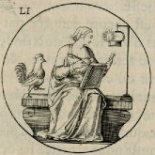Saving Madame de Graffigny
2016 saw the successful completion of a 40-year project: the publication of the Correspondance of Françoise de Graffigny (1695-1758), famous in her time – and again today – as the author of the epistolary novel Lettres d’une Péruvienne and the play Cénie. Spanning 15 volumes, this landmark edition contains more than 2500 letters, annotated by an international team of scholars. It opens in most dramatic fashion, with a battered wife’s desperate plea for help (my translation):
My dear father,
I am forced, in the dire plight where I find myself, to implore you not to abandon me and to have Mr de Rarecour come and get me as quickly as possible, for I am in great danger and am all shattered with blows. I throw myself at your mercy and ask you that this be done very soon. You have to say that others than I informed you, for everyone knows it. I am with much respect your most humble and obedient servant
F. d’Haponcour de Grafigny
The editors date this letter to around 1716, four years into Mme de Graffigny’s disastrous marriage to a profligate, alcoholic, and brutal husband. It is followed by a second letter to her father seeking a practical solution to her plight. In 1723, she obtained legal separation from her husband, who died two years later. Françoise did not marry again.
Letter #1 was known from the Isographie des hommes célèbres, a monumental 1828-30 publication containing hundreds of facsimiles of autograph letters by illustrious men (and women). The original had been supplied by the vicomte de Villeneuve-Bargemont. In 1913, Mme de Graffigny’s first biographer quoted the letter in full, citing the Isographie and adding: “The owner of the autograph is unknown.”1 As a matter of fact, ten years earlier it had been acquired by Simon Gratz, a prominent Philadelphia lawyer and autograph collector (more on him at another time). In February 1903, Gratz purchased the manuscript from the Paris dealer Noël Charavay, who had listed this belle lettre in one of his catalogs at a price of 45 francs.

Noël Charavay, Bulletin d’autographes à prix marqués, no. 323, January 1903, p. 19 (Princeton University Library, Rare Books and Special Collections)
Simon Gratz added the letter to a set of “Notable European Women” which, like the rest of his massive collection, was later transferred to the Historical Society of Pennsylvania, where it is still preserved today.2

Simon Gratz autograph collection, The Historical Society of Pennsylvania, Philadelphia (click for larger view)
The rediscovery of this “lost” autograph provides the opportunity for a close-up comparison of an early 18th-century manuscript and its early 19th-century lithographic reproduction. It should even lead to a (tiny) correction of the text of the letter as published in the Correspondance and elsewhere. At the end of the first line, the editors – working from the facsimile and wishing to respect Mme de Graffigny’s spelling – transcribe: “je me trouvee,” with an odd extra e. The original does not support this reading:
Throughout her life, Mme de Graffigny had a habit of punctuating some of her final e’s, apparently by pressing down the quill before lifting it off the paper. At the end of the word “trouue,” this dot merges with a brownish blot in the paper, but clearly does not form another letter. The facsimile artist, however, added another curl, which does suggest the presence of a second e. In the future, everyone should feel free to quote Mme de Graffigny’s famous inaugural text – “the earliest known piece of writing from her pen”3 – without this supernumerary and apocryphal e!
Seen next to the original, the facsimile as a whole demonstrates rather egregiously the limitations of lithography and its inability to render the particular flow and nuances of early modern handwriting. Closer inspection reveals deviations and distortions affecting almost every single letter. Today, photographic reproductions and digitizations are certainly capable of conveying more faithful impressions – and yet, the original manuscripts continue to be well worth searching for and rescuing.
Volker Schröder
March 8, 2017
Footnotes
1. Georges Noël, Une “Primitive” oubliée de l’école des “cœurs sensibles”: Madame de Grafigny (1695-1758), Paris: Plon, 1913, p. 22.
2. The letter is written on a quarto leaf measuring ca. 8.6 x 6.6 inches (21.9 x 16.7 cm). It has a watermark showing the papermaker’s initials in a cartouche surrounded by a crown and a bunch of grapes (similar to Gaudriault 433-434, commonly used as countermarks); the initials are difficult to make out but appear to be B (or P) and C (or G). There is no address; the verso is completely blank.
3. English Showalter, Françoise de Graffigny: Her Life and Works, Oxford: Voltaire Foundation, 2004, p. 15.

Louis-Jacques Cathelin after Jean-Baptiste Garand, Portrait of Mme de Graffigny (detail), Österreichische Nationalbibliothek, Wien / Digitaler Portraitindex


